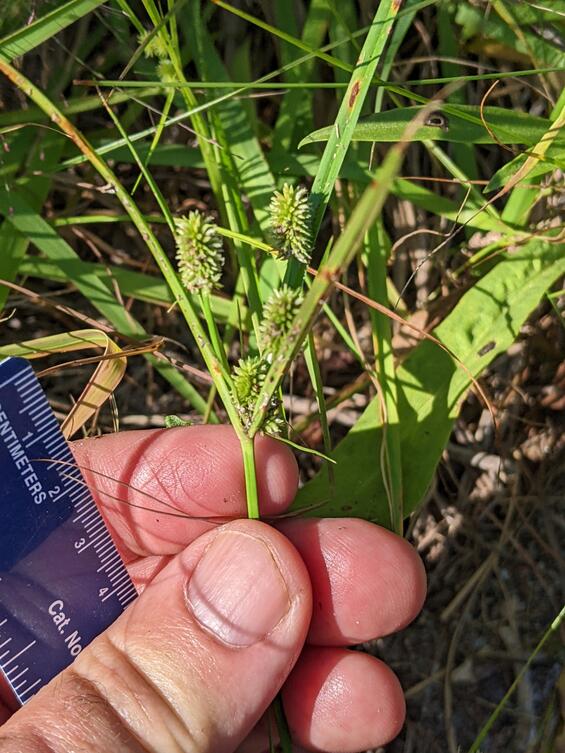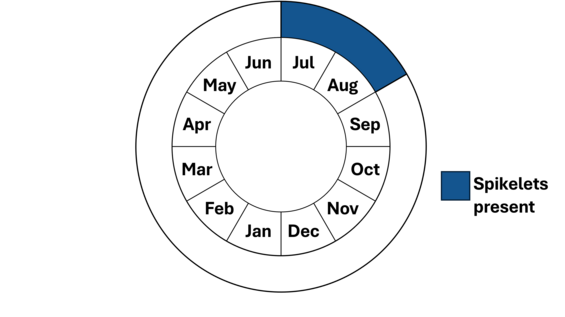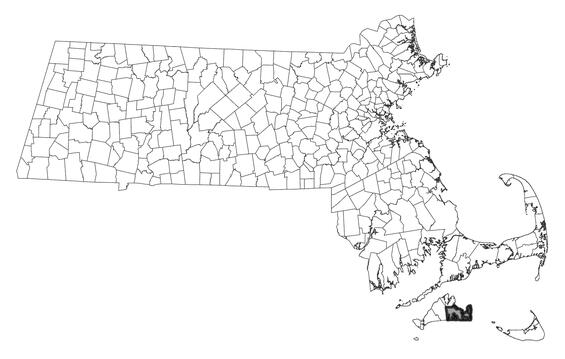- Scientific name: Cyperus retrorsus Chapm.
- Species of Greatest Conservation Need (MA State Wildlife Action Plan)
- Special Concern (MA Endangered Species Act)
Description

Pine barren flatsedge, Cyperus retrorsus, a member of the sedge family (Cyperaceae), is a perennial, herbaceous, grass-like plant that grows in sandy barrens near the coast. The species name, retrorsus, means “turned backward or downward” and refers to the spikelets in the inflorescence. This species grows in clumps and has short rhizomes. It is 20–50 cm (7.9–19.7 in) tall with smooth slightly trigonous stems. Its inflorescence consists of densely oblong ovoid spikes on short rays from the top of the stem. Each spike is 8–16 mm (0.31–0.63 in) tall and 4–12 mm (0.16 – 0.47 in) wide. There are 4–8 rays, each 0.5–3.5 cm (0.2–1.4 in) long. There are 4 to 6 bracts surrounding the stems of the inflorescence. These are 14–30 cm (5.6–11.8 in) long by 1–5 mm (0.04 – 0.20 in) wide and are scabrous on their margins. When ripe, the achenes are brown and oblong–ellipsoid, 1.2–1.7 mm (0.05–0.07 in) long and 0.5–0.6 mm (0.02 in) broad with a papillose (minutely bumpy) surface.
To positively identify pine barren flatsedge and other members of the genus Cyperus, a technical manual should be consulted. Species in this genus have tiny, wind–pollinated flowers that are borne in spikes.
Pine barren flatsedge could be confused with globe flatsedge, Cyperus echinatus. Globe flatsedge is similar in appearance, but its florets are arranged in a sphere instead of an oblong ovoid as in pine barren flatsedge. The scales below each spikelet are longer in globe flatsedge, ranging from 3.5–4.5 mm (0.14–0.18 in) versus 1.8–2.5 mm (0.07–0.10 in) in pine barren flatsedge. In addition, the achenes of globe flatsedge are 1.5–2.3 mm (0.06–0.09 in) compared to the achenes of pine barren flatsedge, which are only 1.2–1.7 mm (0.05–0.07 in).
Life cycle and behavior

Pine barren flatsedge is a perennial, short rhizomatous species. It is wind-pollinated and can spread both by its short rhizomes and by seed. Mature achenes can be found during July and August.
Population status
Pine barren flatsedge is listed under the Massachusetts Endangered Species Act as a species of Special Concern. All listed species are protected from killing, collecting, possessing, or sale and from activities that would destroy habitat and thus directly or indirectly cause mortality or disrupt critical behaviors. There is currently 1 known occurrence in the state verified since 1999. It is found in Dukes County. There are no historical records. It was first documented in the state in 1999. Its population has remained apparently constant at approximately 100 genets (individual plants).
Distribution and abundance
Pine barren flatsedge occurs from Massachusetts south to Florida and west to New Mexico. It is considered globally secure. In New England, it only occurs in Massachusetts. The closest population to the south is on Long Island. It is ranked as critically imperiled in both Massachusetts and New York and possibly extirpated in Missouri and Pennsylvania.

Distribution in Massachusetts
1999-2024
Based on records in the Natural Heritage Database
Habitat
In Massachusetts, the habitat of pine barren flatsedge is a sandy edge of a trail along a tidal pondshore or saltmarsh. Associated species include pitch pine (Pinus rigida), white oak (Quercus alba) with an Ericaceae understory; herbaceous species include woolly rosette-rosettegrass (Dichanthelium lanuginosum), Pennsylvania sedge (Carex pennsylvanica), path rush(Juncus tenuis), and switch panicgrass (Panicum virgatum).
Healthy habitats are vital for supporting native wildlife and plants. Explore habitats and learn about conservation and restoration in Massachusetts.
Threats
Threats to pine barren flatsedge in Massachusetts may include trampling, invasive species such as common reed and sea level rise (Staudinger et al. 2024) even though the current known population occurs within uplands. It is likely that the species requires a level of disturbance to survive, such as trail use, the occasional extreme high tide, or blowing sand.
Conservation
Survey and monitoring
The population of pine barren flatsedge has remained stable since it was first detected. However, there are several possible threats so this species should be monitored regularly, at a minimum of every 3 to 5 years as it is the only population of this species that is known in the state. It is best surveyed in July and August.
Management
Management needs are not known for this species as there is only one population. However, the habitat around the population might be opened so that it could spread into new areas. Seed could be collected, and germination attempted with any new plants generated planted into a new prepared open habitat for them on protected land, on Martha’s Vineyard. If successful, additional populations could be tried in other areas. All active management of rare plant populations (including invasive species removal) is subject to review under the Massachusetts Endangered Species Act and should be planned in close consultation with the MassWildlife’s Natural Heritage & Endangered Species Program.
Research needs
Initially, research that needs to be conducted on this species is to determine if it is producing viable seed. Research is needed to determine whether this plant can be grown in a nursery or garden setting for purposes of reintroductions. Questions about seed germination and seed storage over winter will need to be answered. As sea level rise may create new habitat while at the same time isolating current populations, this strategy for reintroductions could prove useful to long-term conservation of this species. De novo surveys for this species should be conducted in other locations along the coast in open sandy areas; its habitat in other parts of the US is described as open woods, thickets, and rock outcrops in the southeastern United States. Any similar habitats near its current population should be surveyed.
References
Gleason, Henry A., and Arthur Cronquist. Manual of Vascular Plants of Northeastern United States and Adjacent Canada, Second Edition. Bronx, NY: The New York Botanical Garden, 1991.
Haines, A. 2011. Flora Novae Angliae – a Manual for the Identification of Native and Naturalized Higher Vascular Plants of New England. New England Wildflower Society, Yale Univ. Press, New Haven, CT.
NatureServe. 2025. NatureServe Network Biodiversity Location Data accessed through NatureServe Explorer [web application]. NatureServe, Arlington, Virginia. Available https://explorer.natureserve.org/. Accessed: 3/19/2025.
New York Natural Heritage Program. 2023. Online Conservation Guide for Cyperus retrorsus var. retrorsus. Available from: https://guides.nynhp.org/retrorse-flatsedge/ . Accessed 3/19/2025.
POWO (2025). "Plants of the World Online. Facilitated by the Royal Botanic Gardens, Kew. Published on the Internet; https://powo.science.kew.org/ Accessed: 3/19/2025."
Staudinger, M.D., A.V. Karmalkar, K. Terwilliger, K. Burgio, A. Lubeck, H. Higgins, T. Rice, T.L. Morelli, A. D'Amato. 2024. A regional synthesis of climate data to inform the 2025 State Wildlife Action Plans in the Northeast U.S. DOI Northeast Climate Adaptation Science Center Cooperator Report. 406 p. https://doi.org/10.21429/t352-9q86
Wernerehl, Robert and Gregory Palermo. Species Listing Proposal Form: Cyperus retrorsus.2023.
Contact
| Date published: | April 10, 2025 |
|---|